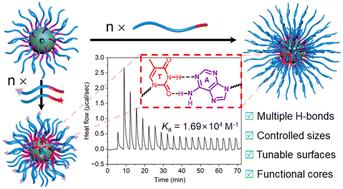通过生物激发的核碱基相互作用克服强位阻,定量和空间定义的纳米结构功能化
IF 7.4
1区 化学
Q1 CHEMISTRY, MULTIDISCIPLINARY
引用次数: 0
摘要
聚合物纳米结构具有可控制和均匀的尺寸,可调的表面性质和空间定义的功能是科学家们高度追求的。然而,精确控制定制的纳米结构仍然是一个艰巨的挑战。在此,我们成功地开发了一种高效和模块化的途径,通过利用聚合物的强大的生物激发核碱基相互作用来克服强位阻,使聚合物纳米结构优雅地功能化。合理设计并制备了含腺嘌呤的核交联纳米结构,在疏水壳层中含有大量垂坠的腺嘌呤。虽然含腺嘌呤的疏水壳层被亲水性电晕层有效地稳定,但生物激发的互补核碱基聚合物之间的特殊多重氢键能够克服强的位阻而有效结合。生物启发氢键相互作用的核碱基表现出优异的选择性,优越的效率和高的结合常数。因此,通过生物激发的核碱基相互作用来定制聚合物纳米结构的尺寸、表面性质和功能是容易和可行的。同时,互补核碱基的模块化强相互作用使我们能够实现合成聚合物纳米结构的定量核心和表面功能化。因此,这项工作为制造定义良好的纳米结构提供了一种新颖的模块化策略,有望为各种生物应用(如精确的纳米疫苗和纳米药物)提供可扩展和优雅的纳米材料。本文章由计算机程序翻译,如有差异,请以英文原文为准。

Quantitative and spatially defined functionalization of nanostructures by overcoming the strong steric hindrance through bioinspired nucleobase interactions
Polymer nanostructures with controlled and uniform sizes, tunable surface properties, and spatially defined functionalities are highly pursued by scientists. However, precise control of tailored nanostructures still represents a formidable challenge. Herein, we have successfully developed an efficient and modular route for elegantly functionalizing polymer nanostructures by harnessing robust bioinspired nucleobase interactions of polymers for overcoming the strong steric hindrance. Adenine-containing core-crosslinked nanostructures were rationally designed and fabricated with numerous pendant adenines in the hydrophobic shell layer. Although the adenine-containing hydrophobic shell layer was effectively stabilized by the hydrophilic corona layer, extraordinary multiple hydrogen bonds between bioinspired complementary nucleobase-containing polymers are capable of overcoming the strong steric hindrance for efficient binding. Bioinspired hydrogen bonding interactions of nucleobases display excellent selectivity, superior efficiency, and high association constants. Therefore, it is facile and feasible to tailor the sizes, surface properties, and functionalities of polymer nanostructures through bioinspired nucleobase interactions. Meanwhile, the modular strong interactions of complementary nucleobases enable us to achieve the quantitative core and surface functionalization of synthetic polymer nanostructures. Thus, this work provides a novel and modular strategy for fabricating well-defined nanostructures, which is promising to furnish scalable and elegant nanomaterials for various biological applications such as precise nanovaccines and nanomedicines.
求助全文
通过发布文献求助,成功后即可免费获取论文全文。
去求助
来源期刊

Chemical Science
CHEMISTRY, MULTIDISCIPLINARY-
CiteScore
14.40
自引率
4.80%
发文量
1352
审稿时长
2.1 months
期刊介绍:
Chemical Science is a journal that encompasses various disciplines within the chemical sciences. Its scope includes publishing ground-breaking research with significant implications for its respective field, as well as appealing to a wider audience in related areas. To be considered for publication, articles must showcase innovative and original advances in their field of study and be presented in a manner that is understandable to scientists from diverse backgrounds. However, the journal generally does not publish highly specialized research.
 求助内容:
求助内容: 应助结果提醒方式:
应助结果提醒方式:


